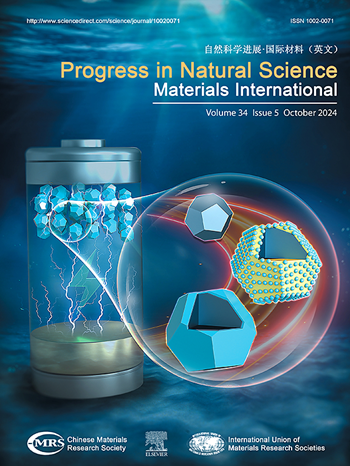Study on the interfacial bonding behavior of dissimilar aluminum alloys via additive friction stir deposition
IF 7.1
2区 材料科学
Q2 MATERIALS SCIENCE, MULTIDISCIPLINARY
Progress in Natural Science: Materials International
Pub Date : 2025-04-01
DOI:10.1016/j.pnsc.2025.02.008
引用次数: 0
Abstract
Conventional fusion-based additive manufacturing methods for dissimilar aluminum alloys often face low efficiency and weak interfacial bonding. The rod-feeding-based additive friction stir deposition (R-AFSD) process improves this by achieving metallurgical bonding through recrystallization without melting the material. This work fills a study gap in multilayer deposition of dissimilar aluminum alloys, focusing on bonding mechanisms and optimizing interfacial properties critical for high-performance dissimilar aluminum alloys structures in aerospace applications. This work fabricated a three-layer deposition of 6061-T6, 2024-T6, and 7075-T6 alloys, characterizing material flow and interfacial microstructure using scanning electron microscopy (SEM) and electron backscattered diffraction (EBSD). Zn enrichment at the 7075/2024 interface resulted in an average grain size of 0.8 μm, enhancing interfacial strength. Shear tests showed that the 7075/2024 interface had the highest shear strength of 232 MPa, while the 6061/2024 interface exhibited a maximum shear strength of 155 MPa with greater plasticity. The multilayer structure of dissimilar aluminum alloys demonstrates superior performance by integrating the strengths of each alloy. The strategic placement of 6061 in the bottom layer provides corrosion resistance, while 2024 enhances fatigue resistance, and 7075 withstands high loads. This study offers novel insights into R-AFSD for dissimilar aluminum alloy deposition, with significant implications for aerospace applications.
添加剂搅拌摩擦沉积法研究异种铝合金的界面结合行为
传统的基于熔合的异种铝合金增材制造方法常常面临效率低、界面结合弱的问题。基于棒料的添加剂搅拌摩擦沉积(R-AFSD)工艺通过再结晶实现冶金结合而不熔化材料,从而改善了这一点。这项工作填补了异种铝合金多层沉积的研究空白,重点研究了航空航天应用中高性能异种铝合金结构的键合机制和优化界面性能。本文制备了6061-T6、2024-T6和7075-T6合金的三层沉积,利用扫描电镜(SEM)和电子背散射衍射(EBSD)表征了材料流动和界面微观结构。在7075/2024界面处富集Zn,平均晶粒尺寸达到0.8 μm,增强了界面强度。剪切试验结果表明,7075/2024界面的最大抗剪强度为232 MPa, 6061/2024界面的最大抗剪强度为155 MPa,具有较好的塑性。异种铝合金的多层结构通过综合各合金的强度表现出优异的性能。6061在底层的战略性放置提供了耐腐蚀性,而2024增强了抗疲劳性,而7075可以承受高载荷。该研究为不同铝合金的R-AFSD沉积提供了新的见解,对航空航天应用具有重要意义。
本文章由计算机程序翻译,如有差异,请以英文原文为准。
求助全文
约1分钟内获得全文
求助全文
来源期刊
CiteScore
8.60
自引率
2.10%
发文量
2812
审稿时长
49 days
期刊介绍:
Progress in Natural Science: Materials International provides scientists and engineers throughout the world with a central vehicle for the exchange and dissemination of basic theoretical studies and applied research of advanced materials. The emphasis is placed on original research, both analytical and experimental, which is of permanent interest to engineers and scientists, covering all aspects of new materials and technologies, such as, energy and environmental materials; advanced structural materials; advanced transportation materials, functional and electronic materials; nano-scale and amorphous materials; health and biological materials; materials modeling and simulation; materials characterization; and so on. The latest research achievements and innovative papers in basic theoretical studies and applied research of material science will be carefully selected and promptly reported. Thus, the aim of this Journal is to serve the global materials science and technology community with the latest research findings.
As a service to readers, an international bibliography of recent publications in advanced materials is published bimonthly.

 求助内容:
求助内容: 应助结果提醒方式:
应助结果提醒方式:


